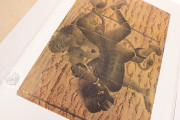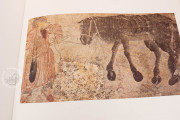The Siyah Qalam Albums comprise 74 color plates sharing both stylistic elements and iconography. These artworks are commonly attributed to Üstad Mehmed Siyah Qalem, as his signature can be found on several of the drawings. Upon closer examination, however, distinct variations emerge among the plates. Further research has allowed for a more precise categorization and attribution to various sources, including the Master himself, his workshop, and his followers.
The sheets are believed to have been painted in Turkestan at the beginning of the fifteenth century. This dating is justified by the presence of certain characteristic features found in paintings from the Timurid period. The origin from Turkestan is indicated by the types of clothing, costumes, headgear depicted, and other iconographic details.
Nomads, Caricatures, and Grotesque Entities
Regarding Siyah Qalam's work, it is probable that these sheets were originally cut from scrolls adorned with various figures. The subjects predominantly feature steppe nomads and Mongols but also include other figures whose physical characteristics are exaggerated to an extreme, resulting in caricatures (representing Turks, Iranians, Syrians, Africans, Indians, and more). These artworks blend scenes of everyday life with religious depictions, often featuring grotesque entities that can be identified as demons.
A Signed Work
The earliest creations of Siyah Qalam unquestionably showcase the skills of an accomplished artist, yet little is known about his life and personal characteristics. It is not uncommon to encounter unsigned works in Eastern art, where artists often remained anonymous. In instances where a signature was deemed necessary, it typically appeared with finesse and in a well-thought-out position. This differs from the somewhat haphazard placement of signatures on the plates under discussion. One hypothesis is that these signatures were added at a later stage, possibly during the organization, collection, or assignment of these plates.
The Journey of the Albums
One theory proposes that the sheets found their way into the Sultan's library at an early stage, possibly during the reign of Mehmed the Conqueror (1453-1481). Consequently, the albums housing them have come to be known as the Fatih albums, named in honor of the Conqueror. Alternatively, they might have been acquired as spoils of war during the rule of Selim I (1512-1520). These albums, referred to as murraqqa'a (which can be translated as collages or patchworks), actually comprise individual sheets containing drawings, sketches, miniatures, paintings, and calligraphy. The fragments now contained within these albums are identified by the shelfmarks Hazine 2153 and 2160 and are currently housed in the Topkapi Museum in Istanbul.
We have 2 facsimiles of the manuscript "Siyah Qalam Albums":
- Siyah Qalem facsimile edition published by Salerno Editrice, 1984
- Siyah Qalem facsimile edition published by Akademische Druck- u. Verlagsanstalt (ADEVA), 1976



















